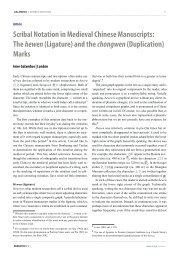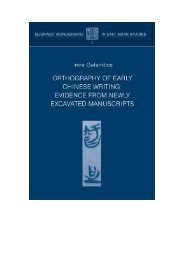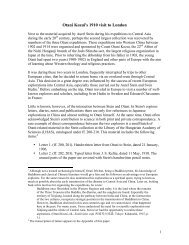Japanese 'Spies' along the Silk Road - Chinese manuscripts
Japanese 'Spies' along the Silk Road - Chinese manuscripts
Japanese 'Spies' along the Silk Road - Chinese manuscripts
You also want an ePaper? Increase the reach of your titles
YUMPU automatically turns print PDFs into web optimized ePapers that Google loves.
38 <strong>Japanese</strong> Religions 35 (1 & 2)<br />
We are much more fortunate with regard to Nomura’s account of <strong>the</strong> Kashgar<br />
events. His diary survived and was later published in Shin Saiiki-ki 新西域記<br />
(New Record of <strong>the</strong> Western Regions), a monumental two-volume work that<br />
ga<strong>the</strong>red <strong>the</strong> diaries, reports and travel accounts from members of <strong>the</strong> three<br />
Ōtani expeditions. 8 Nomura’s diary is meticulous, with an entry for practically<br />
every day. Each entry begins with <strong>the</strong> date, a one-word wea<strong>the</strong>r report (e.g. sunny,<br />
rainy, cloudy), and <strong>the</strong> maximum and minimum temperature. This is followed by<br />
a description of what happened during <strong>the</strong> day, whom he met, what he bought,<br />
where he traveled, etc. It even includes occasional poems Nomura wrote <strong>along</strong> <strong>the</strong><br />
way about things he witnessed.<br />
Nomura’s diary reveals to what extent <strong>the</strong> expeditions were managed by<br />
instructions from Ōtani who was in Japan conducting <strong>the</strong> affairs of his sect with<br />
millions of believers. Amidst his no doubt busy schedule, <strong>the</strong> exploration of Central<br />
Asia was one of his pet projects and a stream of communications ran between<br />
Xinjiang and Nishi Hongan-ji, his headquarters in Kyōto. Tachibana and Nomura<br />
sent telegrams and mailed handwritten reports to him and in return received<br />
instructions by both mail and telegram. Every major decision was made in Kyōto,<br />
and <strong>the</strong> two explorers obediently followed <strong>the</strong>ir orders.<br />
As a telling example of Ōtani’s hands-on management, <strong>the</strong> collection of <strong>the</strong><br />
Ryūkoku University Library includes two small handwritten booklets written by<br />
Ōtani for his expedition members. One of <strong>the</strong>m is <strong>the</strong> Ryokō kyōhan 旅行教範<br />
(Travel Guidelines) in which he gives a long list of general rules to follow in <strong>the</strong><br />
field, including <strong>the</strong> daily distances one should cover on foot or horseback, items<br />
to be recorded in <strong>the</strong> diary, or even what to wear when meeting local officials and<br />
gentlemen. He writes, for example, that “especially on British territory you should<br />
not forget to have a tailcoat at your disposal.” (Ueyama 2001: 34-35) The o<strong>the</strong>r<br />
booklet called Tanken shizusho 探検指図書 (Expedition Instructions) is a detailed<br />
itinerary mailed to Yoshikawa Koichirō 吉川小一郎 (1885-1978), member of <strong>the</strong><br />
third expedition, shortly after he had begun his trip in 1911. These instructions<br />
reveal that to a large extent Ōtani planned <strong>the</strong> entire expedition ahead and<br />
was running it remotely while <strong>the</strong> actual onsite explorers were merely acting in<br />
compliance with his instructions. Accordingly, <strong>the</strong>re was very little leeway for<br />
individualistic ventures, <strong>the</strong> expedition members were always told exactly what<br />
to do. From Nomura’s diary it is apparent that <strong>the</strong> explorers tried to maintain<br />
constant communication with Ōtani, and <strong>the</strong> disruptions caused in this by <strong>the</strong><br />
8. Uehara (1937). This large publication project was initiated by Uehara Yoshitarō 上原<br />
芳太郎 more than 20 years after <strong>the</strong> end of <strong>the</strong> expeditions. Because of <strong>the</strong> time gap,<br />
Uehara often had difficulties in tracking down first-hand material, since some, such<br />
as Tachibana’s diary, had already perished by that time. He contacted each participant<br />
and asked for whatever material <strong>the</strong>y had in connection with <strong>the</strong>ir travels.







